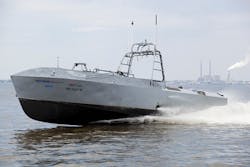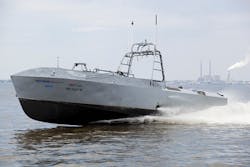Navy orders additional unmanned boats from Textron to provide LCS minesweeping capability
WASHINGTON - Textron Systems Corp. will build fast unmanned boats to provide the U.S. Navy's Littoral Combat Ship (LCS) with unmanned minesweeping capability to detect, pinpoint, and destroy ocean mines.
Officials of the Naval Sea Systems Command announced a $14.8 million order to the Textron Unmanned Systems segment in Hunt Valley, Md., to provide additional units for the Unmanned Influence Sweep System (UISS) program.
The UISS is an unmanned surface vessel (USV) with integrated magnetic and acoustic minesweeping capability that will be part of the LCS mine warfare module. It will provide magnetic and acoustic influence minesweeping capability when deployed from the LCS.
The UISS, which uses the Textron Common Unmanned Surface Vessel (CUSV), will target acoustic, magnetic, and magnetic and acoustic combination mine types, and provide the LCS with a rapid, wide-area coverage mine-clearance capability to neutralize magnetic and acoustic influence mines.
UISS seeks to provide a high area coverage rate in a small, lightweight package with minimal impact on the LCS. The UISS surface vehicle will travel aboard the LCS and will be deployed as necessary to detect, pinpoint, and trigger explosive sea mines hidden under the surface to damage or destroy surface warships or commercial shipping.
The system consists of the CUSV unmanned power boat that tows an acoustic and magnetic minesweeping system that emits acoustic and magnetic signals that provide a false signature that triggers mines. The surface vessel while operating will be far enough away so that it will not be damaged by a detonating mine, Navy officials say.
The UISS will use the Navy's Multiple Vehicle Communications System (MVCS) aboard the LCS, which handles communications between the LCS surface ship and different mission packages - including the UISS - that involve mine countermeasures, anti-submarine warfare, and surface warfare.
For the MVCS the Navy is using the AB3100H embedded computer from Astronics Ballard Technology in Everett, Wash. The AB3100H rugged computer is part of the company's AB3000 line of small, lightweight embedded computers with the Intel E680T processor, MIL-STD-1553 and ARINC 429/708/717 interfaces, Ethernet, USB, video, audio, and PMC expansion. The AB3000 series from Astronics Ballard Technology comes with factory-installed PCI mezzanine card (PMC) modules that enable designers to add an Ethernet switch, synchronous and asynchronous serial interfaces, and isolated double-throw relays.
The Textron CUSV and its unmanned maritime command and control station use a modular architecture that accommodates platform reconfiguration and interchangeable payloads. The CUSV unmanned boat is capable of executing mine warfare; anti-submarine warfare; communications relay; intelligence, surveillance and reconnaissance; anti-surface warfare; and UAS/UUV launch and recovery missions.
Textron will do the work in Hunt Valley and Columbia, Md.; Slidell, La.; Hauppauge, N.Y.; and Lemont Furnace, Pa., and should be finished by September 2018.
FOR MORE INFORMATION visit Textron Unmanned Systems at www.textronsystems.com/what-we-do/unmanned-systems and Astronics Ballard Technology at www.astronics.com.

